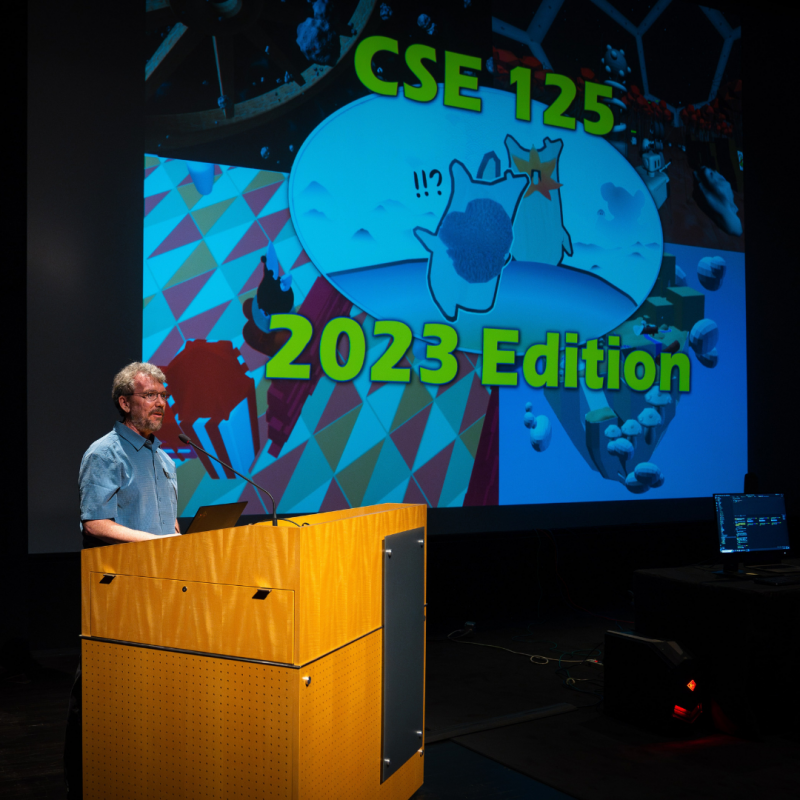Students Stretch the Limits of Time, Space and Imagination with Multiplayer Videogames
 From the vast dimensions of outer space to a colorful circus, from a playful 3D garden to an archipelago of floating islands, these wildly imaginative gaming worlds were conceived by UC San Diego students in the Department of Computer Science and Engineering’s CSE 125, aka “the videogame course.”
From the vast dimensions of outer space to a colorful circus, from a playful 3D garden to an archipelago of floating islands, these wildly imaginative gaming worlds were conceived by UC San Diego students in the Department of Computer Science and Engineering’s CSE 125, aka “the videogame course.”
Each spring, CSE professor Geoffrey M. Voelker teaches the course known officially as “Software System Design and Implementation” to roughly three dozen seniors in computer science. The class challenges students to spend the quarter building a distributed, real-time, 3D multiplayer game, working collaboratively in teams.
At the start of the quarter, the teams all begin with a blank slate. Together, they must decide on the features of their project, specify its requirements, create a schedule and implement their design. The course culminates in a public demonstration, which doubles as the final exam.
“The fact that they’re able to do it in 10 weeks is just absolutely amazing – well-nigh impossible,” said Voelker. “They just don’t know it’s impossible; so, they are able to do it.”
In June, supporters and video game enthusiasts gathered in the Qualcomm Institute auditorium in Atkinson Hall to see the five games created during the 2023 edition of CSE 125. For each demo, audience members were picked to compete alongside the game’s development team.
“Everything that you’re seeing was done by the students in that group,” Voelker told the crowd. “There is no game engine. They implemented the game engine on the client. There’s no standard server. They implemented their own game standard and custom network protocol to hook together the clients with the server. The art as well. Everything is done by the students.” 
“ROOTIN’ TOOTIN’ SPACEMAN SHOOTIN’”
Group One started the event with a demonstration of their action-packed videogame “Rootin’ Tootin’ Spaceman Shootin,’” the creation of Alexander Berryhill-Williams, Victor Chen, Jackson Conte, Katie Hsieh, Sophia Klueter, Farnia Nafarifard and Allen Weng.
In a fun-spirited mash-up of two worlds, astronauts in cowboy hats take to outer space – the final frontier – for an old western shoutout. Four spacemen navigate by lasso, exchange gunfire, and dodge floating asteroids and pioneer wagons – all to determine who will be the last one standing.
“The core mechanic of their game was a lasso for flinging players around in space, and it worked beautifully,” said Voelker.
“MAD MARTIANS”
Group Two also left earth’s atmosphere, setting their game “Mad Martians” on the Red Planet. Game creators – Jeannelle Balilo, Sahil Bhalla, Dillan DeMoss, Vladimir Em, William Hu, Cory Huynh, and Patrick Lin – were inspired by NASA’s Mars rover, Opportunity, which sent a final message 15 years after its landing: “My battery is low, and it’s getting dark.”
“Mad Martians,” an action-packed [GV1] tower defense game, pits four rovers against Martians who have become fed-up with humans trying to gentrify their planet. The rovers must defend their home base and fortify its defenses by collecting resources like crystals and wood. If the base falls, the rovers lose.
“The game play was particularly energetic and lively,” remarked Voelker.
“THE INVISIBLE ONE”
Group Three created “The Invisible One.” In this asymmetrical cooperative game, three players help the remaining player achieve the main objective – to escape the circus by navigating a dark and harrowing maze. But there’s a twist. The central player, a character named Alice, is blind. The other three players must help Alice reach the exit by using their special powers.
“The story of the game is incredibly creative and sensitive,” said Voelker, highlighting CSE students Zhiying Guan, Yucheng Huang, Jiahui Han, Ashley Kou, Yingkai Lee, Jack Wagner, Manshi Yang and Xiaoxiao Zou for both their unusual concept and technical execution.
“TAG GUYS”
Group Four included teammates Matthew Lawrence, Hancheng Lin, Sai Lui, Ann Luong, Yuxiao Qu, Andrew Slater and Sean Ye, who developed “Tag Guys.”
In this multiplayer party game, players select a customizable skin – a bee, trash panda, avocado, CSE’s iconic bear, or something similar – before joining a bright and cheerful open-world layout festooned with mushrooms, flowers, leaves and fallen logs. Once the clock is set to 5 minutes, the aim is simple; avoid getting tagged as “it.”
“They created an incredible 3D world to play the game in,” said Voelker. “It’s unusual for a game in CSE 125 to have a fully 3D environment.”
“AS THE WIND BLOWS”
Group Five wrapped up the 2023 demonstrations with another fast-moving party game, “As the Wind Blows.” Inspired by nature and Guohua art, teammates Yunxiang Chi, Esa Hammado, Binghong Li, Xiyan Shao, Alan Wang, Shuhua Xie, Lingye Zhuang created a game that was both mesmerizing and lively.
Players compete as mischievous Koroks, or forest spirits, fighting to occupy the glorious center island of a floating archipelago. Age-old elements – such as classical Chinese music and traditional art styles and colors – provide a picturesque juxtaposition to the more technical elements in the game, which include wind-based attacks and random weather events.
“Their game was incredibly polished with game play, art and sound – all very coherent to their theme,” said Voelker.
By Kimberley Clementi
